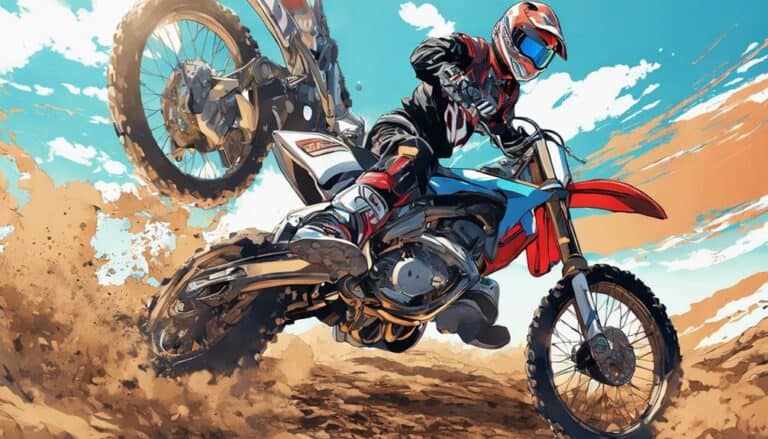When starting your hydraulic clutch dirt bike, it's like walking a tightrope – balance is key. But have you ever wondered about the best timing for engaging the clutch to guarantee a seamless ride?
Understanding the nuances of this process can greatly impact your biking experience. Let's explore the intricacies of starting a dirt bike with a hydraulic clutch and discover the secrets to mastering this essential skill.
Key Takeaways
- Gradually release clutch lever while applying throttle for smooth engagement
- Proper maintenance ensures consistent performance and longevity
- Verify bike is in neutral gear and use proper throttle control
- Hydraulic systems offer precise control for controlled launches and traction
Benefits of Starting With Hydraulic Clutch
Choosing to start your dirt bike with a hydraulic clutch provides numerous advantages that enhance your overall riding experience. The hydraulic clutch offers a smoother engagement, allowing for a more controlled and precise launch. This smooth engagement is important for maintaining traction and avoiding unnecessary wheel spin, especially in challenging off-road conditions.
One of the key benefits of a hydraulic clutch is its self-adjusting nature. This feature guarantees that the clutch maintains ideal engagement every time you start the bike, without the need for manual adjustments. Additionally, hydraulic clutches provide consistent and reliable performance, reducing the chances of stalling and offering a more seamless riding experience.
In comparison to cable clutches, hydraulic clutches require less maintenance and offer a more precise feel, enhancing your overall control of the bike. With a hydraulic clutch, you can achieve quicker and more efficient starts, allowing you to focus on traversing through various terrains with confidence.
Steps to Properly Start the Dirt Bike
How should you prepare the dirt bike for a smooth start? To make certain a seamless start to your dirt bike, follow these essential steps:
- Make certain the bike is in neutral: Before starting the bike, always verify it's in neutral gear to prevent any sudden movement.
- Pull in the clutch lever: By pulling in the clutch lever, you disengage the clutch, allowing for a smoother start of the engine.
- Start the bike: Utilize the electric starter or kickstart based on your bike's model specifications.
Common Issues With Starting Hydraulic Clutch
Starting a dirt bike with a hydraulic clutch may present common issues that require attention for a smooth operation. When dealing with hydraulic clutches, it's essential to be aware of potential problems such as clutch drag, differences in starting techniques, and the importance of proper clutch handling.
To better understand these common issues, refer to the table below:
| Common Issues | Description | Resolution |
|---|---|---|
| Clutch Drag | Normal occurrence during bike start with hydraulic systems. | Fresh oil and a proper bleed usually resolve excessive drag issues. |
| Starting Techniques | Differences in safety switches between Japanese and European bikes can affect starting techniques. | Adjust starting techniques based on the specific bike's safety switch setup. |
| Proper Clutch Handling | Emphasizing proper clutch handling during the starting process is important for hydraulic clutch bikes. | Ensure a smooth clutch engagement process by handling it correctly. |
Understanding these issues and following proper maintenance techniques can greatly improve the performance and longevity of your hydraulic clutch dirt bike.
Tips for Maintaining the Hydraulic Clutch
To maintain peak performance and longevity of your hydraulic clutch dirt bike, adhere to these essential maintenance tips:
- Regularly check the fluid level in the hydraulic clutch reservoir to guarantee proper lubrication.
- Bleed air from the hydraulic clutch system after fluid changes to maintain peak performance.
- Lubricate the clutch lever pivot regularly to prevent sticking or stiffness in the operation.
Proper maintenance of your hydraulic clutch system is vital for peak performance. Regularly inspecting the fluid level in the reservoir ensures that the clutch remains properly lubricated, preventing premature wear and ensuring smooth operation.
After fluid changes, bleeding air from the system is essential to maintain consistent clutch feel and performance. Additionally, keeping the clutch lever pivot lubricated helps prevent any sticking or stiffness during operation, ensuring seamless engagement.
Importance of Proper Clutch Engagement
Proper clutch engagement on a dirt bike is essential for ensuring smooth power delivery and control during starts. When engaging the clutch, it's vital to find the right balance between releasing it too quickly, which can cause sudden jerks or stalls, and letting it out too slowly, which may result in a sluggish start. Smooth power delivery is achieved by gradually releasing the clutch lever while simultaneously applying throttle to match the engine's RPM. This synchronized action prevents abrupt changes in power output, optimizing traction and acceleration from a standstill.
Understanding the intricacies of hydraulic clutch operation is key to mastering proper clutch engagement. Hydraulic systems provide consistent and precise control over the clutch engagement process, allowing for seamless modulation of power delivery. By familiarizing yourself with the feel and response of a hydraulic clutch, you can fine-tune your starts for maximum efficiency and performance. Remember, a well-executed clutch engagement not only enhances your riding experience but also prolongs the lifespan of your clutch components.
Conclusion
To summarize, just as a skilled musician tunes their instrument before a performance, ensuring your hydraulic clutch dirt bike is properly started is essential for a smooth ride.
By taking the necessary steps to maintain and engage the clutch correctly, you can unleash the full potential of your bike and experience the true joy of riding.
Remember, the key to success lies in the details.

